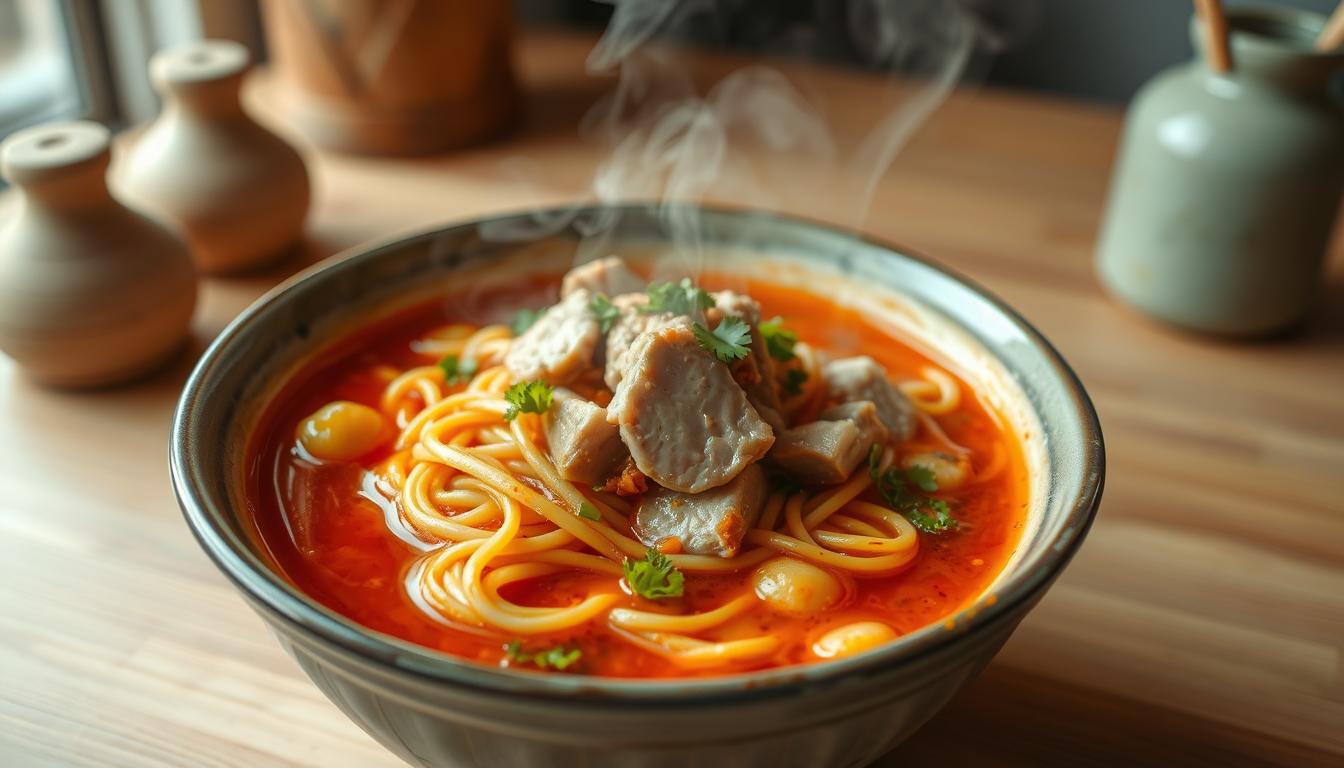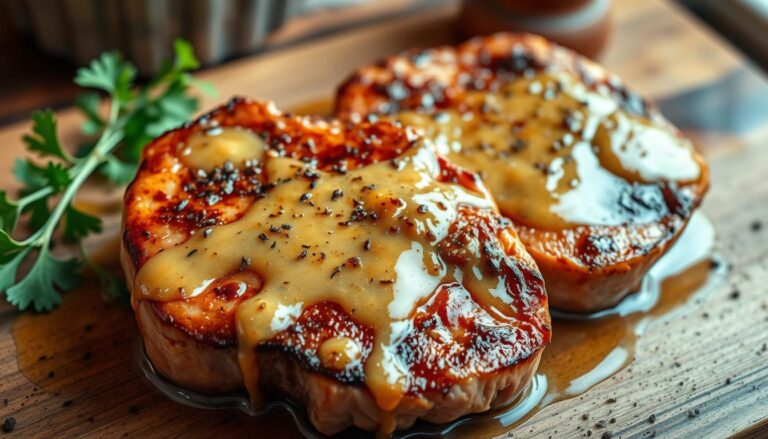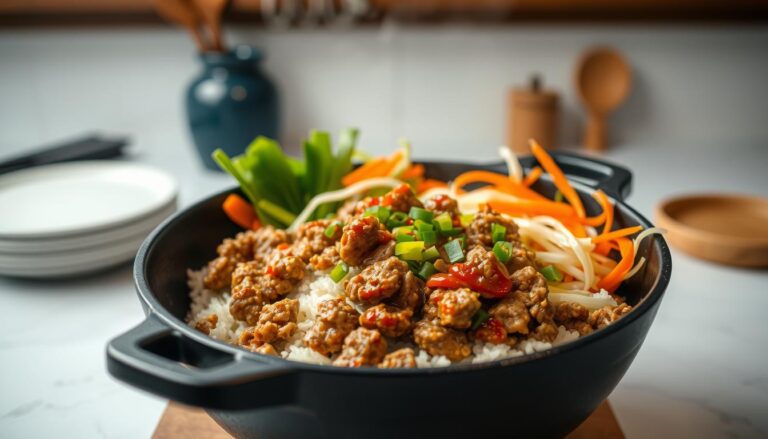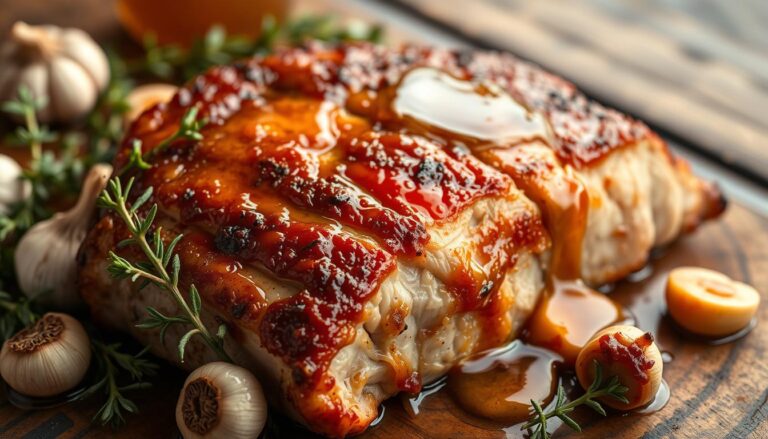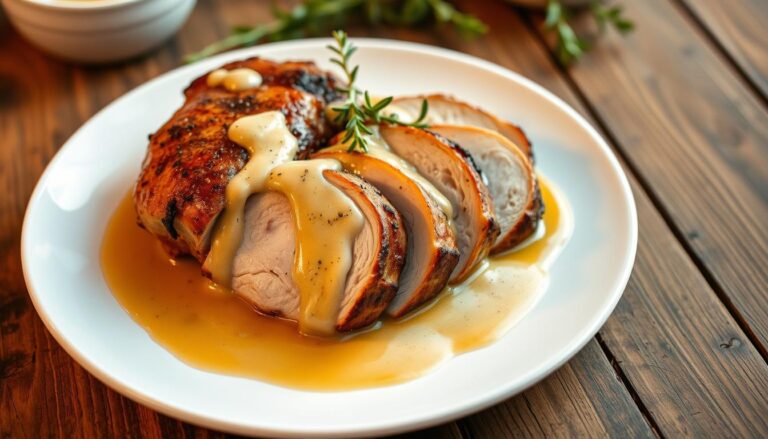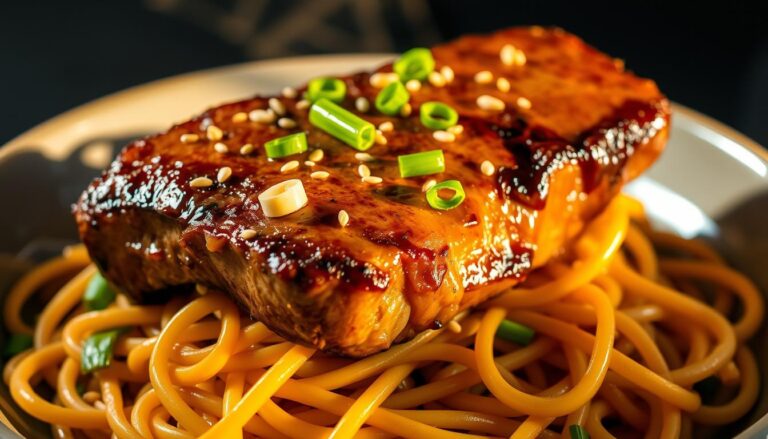Korean Gochujang Noodles: Spicy, Savory, & Easy to Make
Ever crave a meal that feels like a warm hug but packs a punch of excitement? Picture this: a busy weeknight, your kitchen filled with the aroma of smoky-sweet spices, and a dish that comes together faster than takeout. That’s the magic of gochujang sauce—a flavor powerhouse that turns simple ingredients into something unforgettable.
This recipe isn’t just about heat. It’s a dance of tangy, savory, and umami notes, all clinging to chewy udon or ramen noodles. Fresh veggies like crisp bell peppers and tender mushrooms add brightness, while a glossy, irresistibly thick sauce ties everything together. Best part? You’re 30 minutes away from a meal that rivals your favorite Korean restaurant.
No fancy techniques required. Whether you’re a beginner or a seasoned cook, this dish adapts to your pantry. Swap proteins, adjust spice levels, or toss in seasonal veggies—the versatile gochujang base welcomes creativity. Let’s turn your kitchen into a flavor playground.
Key Takeaways
- Gochujang sauce delivers a unique blend of spicy, sweet, and savory flavors in every bite.
- Fresh udon noodles and colorful vegetables create satisfying textures and visual appeal.
- Prep-to-table time takes just 30 minutes, ideal for busy weeknights.
- Customize spice levels and ingredients to suit personal preferences.
- Restaurant-quality results require only basic cooking skills and tools.
Introduction to Korean Gochujang Noodles
Spicy, tangy, and irresistibly savory—this recipe transforms pantry staples into magic. At its core lies gochujang paste, a fermented chili marvel that brings depth to every bite. Paired with fresh garlic and nutty sesame oil, it creates a sauce that clings perfectly to chewy noodles.
Discovering the Unique Flavors
Balance defines this dish. The sauce combines sweet mirin, salty soy, and fiery gochujang in precise ratios. Fresh garlic adds aromatic punch, while a splash of rice vinegar cuts through richness. Together, they create what chefs call “flavor layering”—each ingredient shines without overpowering others.
| Component | Role | Pro Tip |
|---|---|---|
| Gochujang | Spicy base | Use fermented paste for complexity |
| Soy Sauce | Salty backbone | Low-sodium lets you control saltiness |
| Sesame Oil | Nutty finish | Add last to preserve flavor |
Why You’ll Love This Recipe
Three words: speed, simplicity, versatility. From pot to plate in 25 minutes, it beats takeout lines. The sauce comes together while noodles boil—no special skills needed. Leftover veggies? Toss them in. Prefer tofu over chicken? Swap freely. This adaptable blueprint welcomes your creativity.
Weeknight warriors rejoice: you get restaurant-quality results using one pan. The glossy sauce coats every strand, delivering bold flavors that linger pleasantly. It’s the kind of meal that makes you feel like a kitchen hero—without the cleanup drama.
Essential Ingredients and Flavor Foundations
Unlock the secret to bold flavors with three kitchen staples that transform simple meals. The magic happens when gochujang’s fermented chili depth meets soy sauce’s umami punch and sesame oil’s aromatic finish. Each plays a critical role in building layers of taste that cling to every bite.
Key Components: Gochujang, Soy Sauce, and Sesame Oil
Gochujang delivers slow-building heat with sweet undertones, while soy sauce adds salty balance. Toasted sesame oil—the third pillar—brings nutty richness. Together, they create a sauce that’s greater than the sum of its parts:
| Ingredient | Flavor Role | Expert Tip |
|---|---|---|
| Gochujang | Spicy foundation | Choose brands with rice syrup for authentic sweetness |
| Soy Sauce | Salty depth | Use 1:1 with water if reducing sodium |
| Sesame Oil | Aromatic finish | Add off-heat to preserve delicate notes |
Ingredient Substitutions for a Customized Dish
Dietary needs? Swap smartly. Tamari replaces soy sauce for gluten-free needs, while honey mimics mirin’s sweetness. Can’t handle heat? Reduce gochujang by half and add 1 tsp rice vinegar for tang.
Pro tip: Visit Asian markets for premium ingredients. “Quality sesame oil should smell like toasted nuts, not chemical cleaners,” advises Seoul-based chef Mina Park. For vegan versions, skip fish sauce and double the mushrooms’ cooking time to boost savoriness.
Step-by-Step Instructions for Perfect Noodles
Transform your kitchen into a flavor lab with these foolproof techniques. Precision here ensures your dish achieves that restaurant-quality bite and glossy finish every time.
Cooking the Noodles to the Right Texture
- Boil water with 1 tsp salt—it should taste like mild seawater.
- Add udon or ramen, stirring immediately to prevent sticking.
- Cook 1 minute less than package instructions—they’ll finish cooking in the sauce later.
- Reserve ½ cup starchy noodle water before draining.
This undercooking method prevents mushiness. The starch-rich water acts as a natural thickener, helping the sauce cling better.
Whisking Up the Gochujang Sauce
| Ingredient | Measurement | Purpose |
|---|---|---|
| Gochujang | 3 tbsp | Spicy backbone |
| Rice vinegar | 2 tbsp | Tangy balance |
| Soy sauce | 1 tbsp | Umami depth |
Whisk these with 1 tsp minced garlic and ½ tsp grated ginger. Heat 1 tbsp oil in a pan—medium-low prevents burning. Sauté aromatics until fragrant (15 seconds), then pour in the sauce mixture.
Add reserved noodle water gradually until it coats a spoon. Toss in cooked noodles, using tongs to fold gently. Finish with sliced scallions and crushed pepper on top for fresh contrast.
Tips and Tricks for Enhancing Your Recipe
Elevate your dish from good to unforgettable with chef-approved tricks that unlock hidden depths of flavor. These professional kitchen hacks require zero extra ingredients—just smart techniques.
Saving Noodle Water and Toasting Sesame Seeds
That cloudy water from boiling pasta? Liquid gold for sauce texture. Reserve ½ cup before draining—its starch helps thicken the glaze naturally. Stir it into your gochujang mixture one tablespoon at a time until it coats the back of a spoon.
Toasted sesame seeds add crunch and aroma. Heat a dry skillet over medium. Add seeds and shake constantly until golden—about 90 seconds. Remove immediately to prevent burning. Sprinkle over finished plates for nutty contrast.
- Balance heat smartly: Too fiery? Add 1 tsp honey. Need more kick? Mix in chili flakes
- Thicken sauces fast: Simmer 2 minutes longer or add ½ tsp cornstarch slurry
- Layer flavors: Finish with lime zest or chopped herbs for brightness
Pro tip from LA chef Jiho Kim: “Always taste your sauce before tossing noodles. Adjust soy sauce for saltiness first—it’s easier to add than remove.” For extra richness, swirl in 1 tsp butter during the final toss.
Exploring Variations and Customizations
Want to make each bowl uniquely yours? This dish thrives on personal twists. Swap, add, or substitute ingredients to match your cravings or dietary needs. The base sauce acts like a flavor magnet—it pairs beautifully with almost anything you toss in the pan.
Vegetable and Protein Additions
Crunchy Napa cabbage and sweet bell peppers bring vibrant color and nutrients. Sauté them first for caramelized edges, or add raw for fresh crispness. Mushrooms soak up the savory sauce like flavor sponges, while snap peas retain their satisfying pop.
For protein power, try cubed tofu or crumbled tempeh. Press firm tofu for 15 minutes, then pan-fry until golden. “Marinate proteins in soy sauce first for deeper flavor penetration,” suggests plant-based chef Lena Park. Meat lovers can add thinly sliced beef or shrimp—cook them separately before combining.
| Add-In | Prep Method | Texture Impact |
|---|---|---|
| Tofu | Pan-sear | Chewy exterior |
| Bell Peppers | Quick stir-fry | Crunchy sweetness |
| Spinach | Wilt at end | Silky contrast |
Try these customization steps:
- Double veggies for a lighter meal
- Mix proteins—try tofu + shrimp
- Char ingredients slightly for smoky notes
Presentation matters. Arrange bright veggies on bowl rims and place proteins centrally. Drizzle extra sauce in zigzags for visual flair. Your pan-fried masterpiece becomes a feast for eyes and palate alike.
Understanding the Role of Gochujang and Korean Flavors
Centuries of culinary tradition simmer in every spoonful of this fermented marvel. Gochujang’s story begins in Korea’s Joseon Dynasty (1392–1897), where households stored chili paste in onggi clay pots to develop its signature depth.
From Royal Courts to Modern Kitchens
Originally made with just chili powder, rice, and soybeans, early recipes focused on preservation. The 16th-century introduction of chili peppers transformed it into the complex spice blend we know today. Modern versions often include sweeteners, but traditional methods still thrive in Korean markets.
| Traditional Use | Modern Adaptation | Key Difference |
|---|---|---|
| Fermented 1+ years | 3-month quick batches | Depth of flavor |
| Clay pot storage | Glass jar packaging | Microbial activity |
| Whole chili flakes | Fine chili powder | Texture variation |
Balance defines authentic Korean cooking. Gochujang delivers heat that builds gradually, not overwhelms. Fresh scallions provide a crisp counterpoint—their sharp bite cuts through richness while adding visual freshness.
Understanding this heritage transforms your cooking. When you layer fermented spice with fresh garnishes, you’re not just making dinner. You’re continuing a 600-year-old conversation between tradition and innovation.
Mastering korean-gochujang-noodles: Techniques and Adjustments
Need to tweak your dish for dietary needs without losing flavor? Small changes make big differences. Whether managing spice sensitivity or gluten intolerance, these pro tips keep your meal deliciously inclusive.
Customizing Heat and Dietary Needs
Control fiery flavors easily. For milder versions, mix 1 tsp sugar with 2 tbsp water to balance heat. Too sweet? Add ½ tsp rice vinegar per cup of sauce. Gluten-free swaps:
| Standard Ingredient | GF Alternative | Grocery Tip |
|---|---|---|
| Soy Sauce | Tamari | Check for “gluten-free” labels |
| Udon Noodles | Rice Noodles | Use 1 package (8 oz) for 4 servings |
| Mirin | Apple Cider Vinegar + Sugar | Mix 1:1 ratio |
Chef Mina Lee advises:
“Always taste as you adjust—flavors intensify when heated.”
Perfecting Sauce Texture
Thick or thin? Reserved noodle water is your secret weapon. Start with ¼ cup, adding 1 tbsp at a time until glossy. For lower fat content, reduce sesame oil by half and boost garlic.
- Too thick: Stir in broth (2 tbsp increments)
- Too thin: Simmer 2 extra minutes
- Grocery hack: Brands vary—taste test sauces before cooking
Balance richness with acidity. A squeeze of lime or dash of vinegar cuts through heavy textures. Remember: 1 tbsp sugar equals 2 tsp honey in sweetness—adjust accordingly.
Storing and Reheating Your Saucy Noodles
Leftovers taste even better when handled right. Proper storage preserves textures and flavors, letting you enjoy your creation for days without quality loss. Follow these simple methods to keep every bite as vibrant as day one.
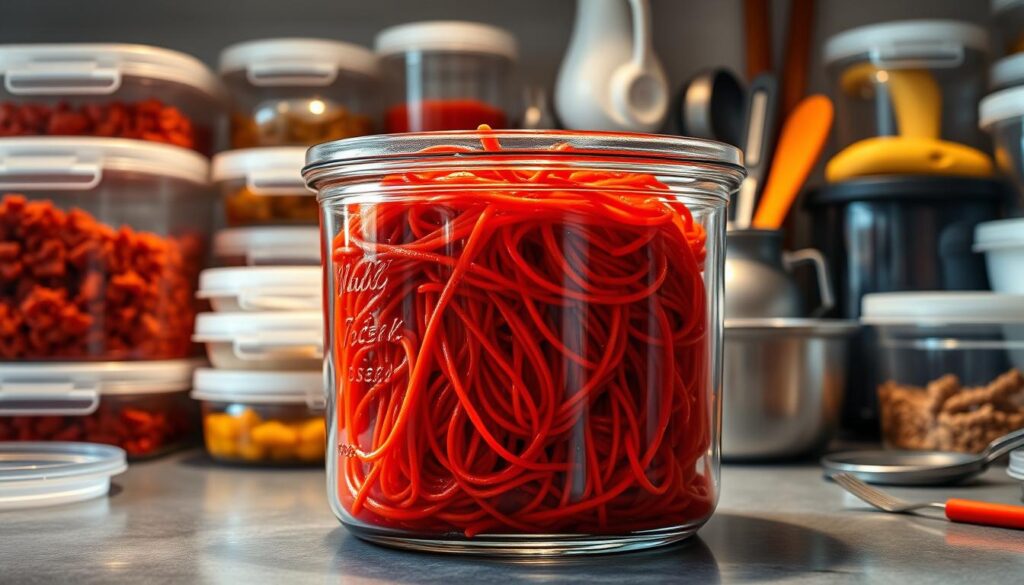
Keeping It Fresh for Future Meals
Separate the sauce from ingredient additions if possible. Store noodles and veggies in airtight containers—they’ll stay fresh for 3-4 days. For protein like tofu or shrimp, refrigerate in shallow dishes to cool faster.
Freeze portions in labeled bags for up to 6 weeks. Thaw overnight before reheating. Pro tip: Add minced garlic cloves when rewarming to revive aromatic depth.
| Storage Method | Duration | Texture Tip |
|---|---|---|
| Refrigerator | 3-4 days | Layer sauce on bottom |
| Freezer | 6 weeks | Use freezer-safe bags |
Reheat gently to avoid mushiness. Microwave users: Sprinkle 1 tbsp water over noodles, cover loosely, and heat in 30-second bursts. Stir between intervals for even warmth.
Stovetop masters prefer a pot on medium-low. Add reserved noodle water (2 tbsp) and stir constantly. For extra protein, toss in fresh shrimp or edamame during reheating.
Revive thick sauces with a splash of broth. Garnish with toasted sesame seeds or fresh herbs to refresh presentation. Your stored ingredient combinations will taste like they just left the pot.
Conclusion
Mastering this dish starts with three essentials: gochujang paste for fiery depth, toasted sesame seeds for crunch, and aromatic sesame oil that ties flavors together. You’ve learned to balance heat with sweetness, adjust textures using starchy water, and layer ingredients for maximum impact. Now, make it yours.
Swap sesame oil with peanut butter for creaminess, or brighten sauces with rice vinegar. These tweaks honor Korean traditions while letting your taste buds lead. Remember—quality matters. Authentic gochujang paste delivers complexity store-bought blends can’t match.
Your kitchen, your rules. Try meatless Mondays with crispy tofu or amp up veggies for color. Each version teaches something new. Share your creations, tweak spice levels, and revisit the recipe as seasons change.
Ready to join the flavor revolution? Whip up your first batch tonight. Tag your masterpiece online, and watch how one adaptable dish becomes a weekly staple. The journey from pantry to plate starts now.
FAQ
Can I substitute gochujang paste if I can’t find it?
While authentic gochujang paste is ideal, you can mix Sriracha with miso or a bit of honey for a similar spicy-sweet flavor. Note that substitutions will alter the dish’s traditional Korean taste.
How do I reduce the spice level without losing flavor?
Use less gochujang paste and balance it with extra soy sauce or a teaspoon of peanut butter. Adding a pinch of sugar or rice vinegar can also soften the heat while keeping the sauce rich.
Are there gluten-free options for this recipe?
Yes! Swap regular soy sauce for tamari and use gluten-free rice noodles or sweet potato starch noodles. Always check labels to ensure ingredients meet dietary needs.
Can I add protein to this dish?
Absolutely. Pan-fried tofu, shredded chicken, or sautéed shrimp pair well. Cook your protein separately and toss it in during the final mixing step for optimal texture.
How long do leftovers stay fresh?
Store leftovers in an airtight container in the fridge for up to 3–4 days. Reheat gently in a pan with a splash of water to revive the sauce’s consistency.
Why is sesame oil important in the sauce?
Toasted sesame oil adds nutty depth and aroma that complements gochujang’s heat. For best results, use high-quality oil and drizzle it just before serving.
Can I freeze these noodles for later?
Freezing isn’t recommended, as the sauce may separate and noodles can become mushy. For meal prep, store components separately and assemble before eating.

